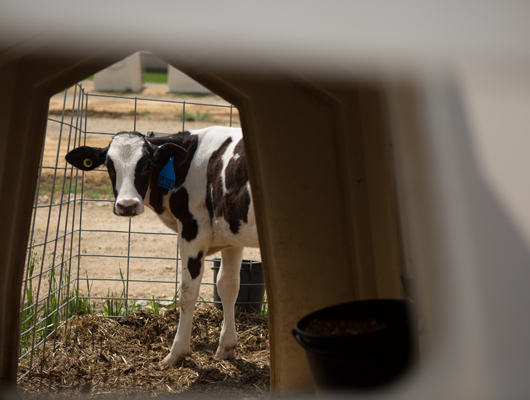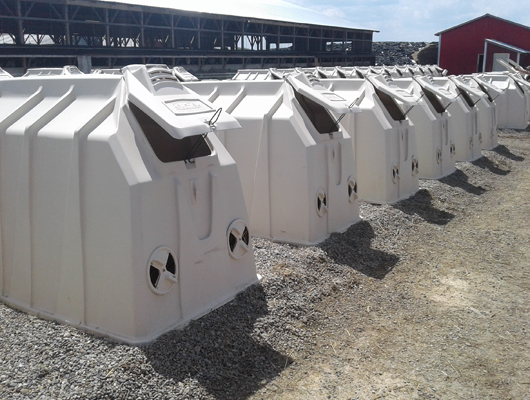
The temperatures are warming up and it is time to think about ways to manage the fly population around our calf facilities. Flies are the major pest problem for dairy calves and are more than just a nuisance as they can also spread diseases like E. Coli and Salmonella. Flies can also keep calves from resting comfortably, causing them stress and reducing growth rates. And I would be remiss if I didn’t mention that flies present the same challenges to the calf care team. So, let’s talk about some measures than can help create a healthy, stress-free calf zone for all parties.
Identify the pests. Knowing the types of flies that you are dealing with as well as their lifecycle is the first key in developing an effective fly management plan. Stable flies, house flies, and blow flies, all commonly classified as “filth flies”, are the most common types found around dairies. They are labeled “filth flies” because they prefer moist conditions and like to lay their eggs in manure, decaying organic matter, spilled or spoiled feedstuffs, and damp bedding, according to Dairy Herd Management. Other common flies that are more often found in pastures or open areas can include horse flies, deer flies, face flies, horn flies, and even mosquitoes. Several of these pests are biting flies that require a “blood meal” and can be quite disturbing to calves. Sarah Morrison, researcher at W.H. Miner Institute, Chazy, NY, notes that stable flies cause painful bites on the lower legs of calves, damaging their tender skin, even to the point of causing noticeable hair loss and scab formation. (Hanson) House flies are the most prevalent in numbers and while they don’t bite, they are effective carriers of disease. The Cornell University College of Veterinary Medicine notes that the house fly’s life cycle is a quick 10 days, while stable flies complete their life cycle in 3 to 4 weeks. (Bertoldo)
Control Options. While it may feel like fly season is still weeks away, it is much more effective to start fly control measures before flies appear. It is important to develop an integrated pest management plan (IPM) to maximize fly control efforts at your operation. IPM focuses on three key areas: sanitation, biological control, and chemical control. (Hanson) Take the time now to walk around your farm facilities, identifying any fly breeding areas and where maggots might live, then determine how to make these areas less attractive to flies.
Keep it clean. Both house and stable flies breed in manure, decaying silage, and moist bedding or feedstuffs, making sanitation the key management practice. Since the house fly life cycle is just 10 days, cleaning everything possible weekly is most desirable and removing any spilled or leftover feeds daily is also helpful. Spreading manure in a thin layer to promote quick drying can also help. (Bertoldo)
Another important sanitation measure is keeping the bedding in the calf housing area dry. Some farms switch to sand, wood shavings or sawdust as bedding material instead of straw in the warmer months of the year. Opening rear doors and vents on Calf-Tel hutches or pens to encourage airflow will also help keep the bedding dry.

Biological control. Releasing natural predators in the spring months can help keep fly populations from blooming. Parasitic wasps, Muscidifurax raptor, will selectively lay their eggs in the larvae of house and stable flies and effectively prevent it from developing. This is the only species of wasp that is effective against the house fly, according to Cornell University’s College of Veterinary Medicine, and should be released on a weekly basis from mid-May through August in northern states. (Bertoldo) Additionally there are beetles and mites that are also predatory to flies, but “these insects are also subject to the same chemical control effects as the flies, meaning that residual insecticides and larvicides cannot be used in conjunction with parasitic wasp releases”, notes Dr. Gerald Bertoldo, DVM with Cornell’s Pro-Dairy team.
Another option is an insect growth regulator, which is a feed additive that can be added to milk or milk replacer beginning several weeks before the start of fly season. Implementing a feed-through larvicide before flies’ hatch works by disrupting the development of the fly’s exoskeleton in immature flies, killing them so they do not become adult flies. (Dairy Herd Management) This break in the life cycle results in fewer flies buzzing around later and does not require extra time or labor to implement. If these products are part of your IPM, be sure to read the label and feed them until 30 days after cold weather arrives for best results.
Chemical control. At times judicious use of short acting chemical methods may be needed to supplement fly control measures. Long acting residual products can provide an immediate effective knockdown, but a resistance can develop to them. Space sprays and baits are effective and less apt to promote resistance. (Bertoldo) Items like fly bait traps, pour-on insecticides, fly bait poisons and sticky tapes can also work well as part of an integrated pest management plan.
An added perk. An effective fly control program creates a much more pleasant environment for both the calves and the people caring for them.
Sources:
- Bertoldo, Jerry, DVM. (Internet). Bedding, bugs and calves: maintaining comfort and health. Retrieved from https://www.vet.cornell.edu/animal-health-diagnostic-center/programs/nyschap/modules-documents/housing-bedding-fly-control
- Dairy Herd Management. (Internet). Fly control strategies for dairy calves and heifers. Retrieved from https://www.dairyherd.com/article/fly-control-strategies-dairy-calves-and-heifers
- Dairy Herd Management. (Internet). Fly population management on dairies. Retrieved from https://www.dairyherd.com/article/fly-population-management-dairies
- Hanson, Maureen. (Internet). Protect your calves during fly season. Retrieved from https://www.dairyherd.com/article/protect-your-calves-during-fly-season?mkt_tok=eyJpIjoiT0RJME1qWTROV0ZsTkRBNSIsInQiOiJcL2RaOWs4YmFNMExRSXRaY0lseWRGbkFkTXVjSkw0M1RJOXRPXC84WVhjYzZTN2pTbStmdk81MkdMRV
- Loftin, Kelly M. & R. Corder. (Internet). Fly Control for Organic Dairies. Retrieved from https://www.uaex.edu/publications/PDF/FSA-7072.pdf
- Purina Animal Nutrition. (Internet). How to get a head-start on fly control. Retrieved from https://www.purinamills.com/dairy-feed/education/detail/how-to-get-a-head-start-on-fly-control
Courtesy of our dealer – CRI REPRODUCCIÓN ANIMAL MÉXICO SA DE CV.
